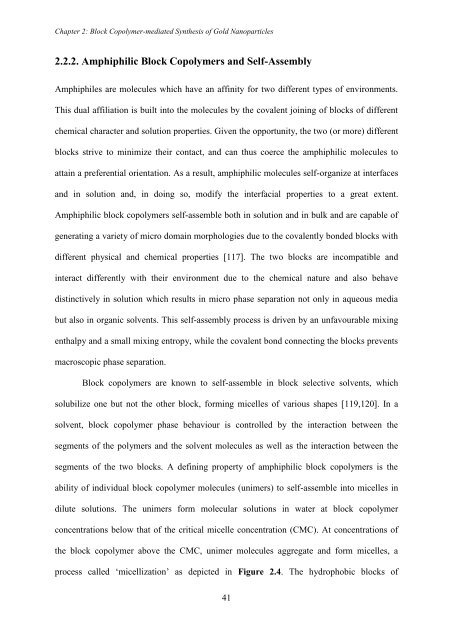PHYS01200704032 Debes Ray - Homi Bhabha National Institute
PHYS01200704032 Debes Ray - Homi Bhabha National Institute
PHYS01200704032 Debes Ray - Homi Bhabha National Institute
Create successful ePaper yourself
Turn your PDF publications into a flip-book with our unique Google optimized e-Paper software.
Chapter 2: Block Copolymer-mediated Synthesis of Gold Nanoparticles<br />
2.2.2. Amphiphilic Block Copolymers and Self-Assembly<br />
Amphiphiles are molecules which have an affinity for two different types of environments.<br />
This dual affiliation is built into the molecules by the covalent joining of blocks of different<br />
chemical character and solution properties. Given the opportunity, the two (or more) different<br />
blocks strive to minimize their contact, and can thus coerce the amphiphilic molecules to<br />
attain a preferential orientation. As a result, amphiphilic molecules self-organize at interfaces<br />
and in solution and, in doing so, modify the interfacial properties to a great extent.<br />
Amphiphilic block copolymers self-assemble both in solution and in bulk and are capable of<br />
generating a variety of micro domain morphologies due to the covalently bonded blocks with<br />
different physical and chemical properties [117]. The two blocks are incompatible and<br />
interact differently with their environment due to the chemical nature and also behave<br />
distinctively in solution which results in micro phase separation not only in aqueous media<br />
but also in organic solvents. This self-assembly process is driven by an unfavourable mixing<br />
enthalpy and a small mixing entropy, while the covalent bond connecting the blocks prevents<br />
macroscopic phase separation.<br />
Block copolymers are known to self-assemble in block selective solvents, which<br />
solubilize one but not the other block, forming micelles of various shapes [119,120]. In a<br />
solvent, block copolymer phase behaviour is controlled by the interaction between the<br />
segments of the polymers and the solvent molecules as well as the interaction between the<br />
segments of the two blocks. A defining property of amphiphilic block copolymers is the<br />
ability of individual block copolymer molecules (unimers) to self-assemble into micelles in<br />
dilute solutions. The unimers form molecular solutions in water at block copolymer<br />
concentrations below that of the critical micelle concentration (CMC). At concentrations of<br />
the block copolymer above the CMC, unimer molecules aggregate and form micelles, a<br />
process called „micellization‟ as depicted in Figure 2.4. The hydrophobic blocks of<br />
41

















